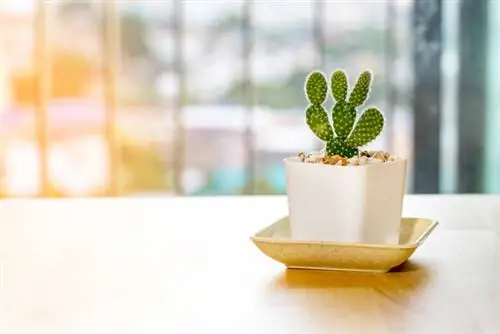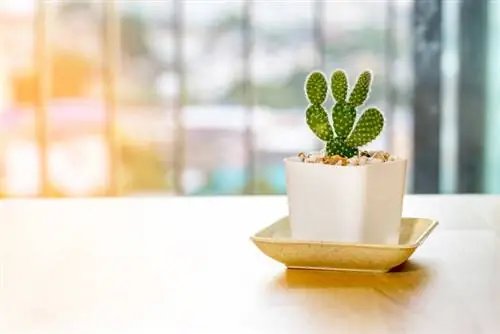- Author admin [email protected].
- Public 2023-12-16 16:46.
- Last modified 2025-06-01 06:02.
With their thorn-strewn bodies, cacti differ significantly from classic houseplants. This difference is not only noticeable visually, but also in terms of care. We have summarized for you here how you can take excellent care of cacti in your room.

How do I properly care for cacti in the room?
For the proper care of indoor cacti, you should let the substrate almost dry out, use soft, lime-free water and spray leaf cacti every 1 to 2 days. In winter, cacti should be moved to a bright, cool room and watered less. Fertilize the plants every other watering from March to September.
Watering alternating between abundance and scarcity - this is how it works
The water supply should simulate natural conditions. Desert cacti thrive as succulents that store water during periods of rainy weather in order to survive bone-dry times in one piece. Cacti are therefore not used to a permanently moist substrate. How to water your houseplants correctly:
- Let the substrate almost dry out
- Let soft, lime-free water run onto the root disk until the saucer fills up
- Small cactus species only water again after about a week
- For large cactus species, take a break from watering for 4 to 6 weeks
Since all cacti cannot stand calcareous, hard water, please only use rainwater or decalcified tap water. Please spray leaf cacti every 1 to 2 days. The substrate on these plants should not dry out as much as desert cacti would like.
Fertilizing and watering go hand in hand
Providing nutrients for indoor cacti is uncomplicated. From March to September, add some liquid cactus fertilizer (€7.00 on Amazon) to the water every second watering.
Moving into the bedroom is desirable in winter
If cacti continue to stay in the well-heated living room in winter, the next flowering period will be poor. By modifying the site conditions and care as follows, you can overwinter the plants appropriately:
- Wear in a bright, cool bedroom from November to February
- Do not water or water minimally at 5 to 12 degrees Celsius
- Do not give fertilizer
At the beginning of March, the rested cacti move to their regular place on the sunny, warm windowsill. Now spray the plants with lime-free water to signal the end of winter dormancy. A week later, water and fertilize the houseplants as usual.
Tip
Winter-blooming leaf cacti have gained a regular place among the most popular houseplants. Above all, the Christmas cactus (Schlumberga), which puts on its blossoms just in time for the festival. In contrast to desert cacti, cacti without spines prefer a partially shaded, humid location and thrive all year round at normal room temperatures.






